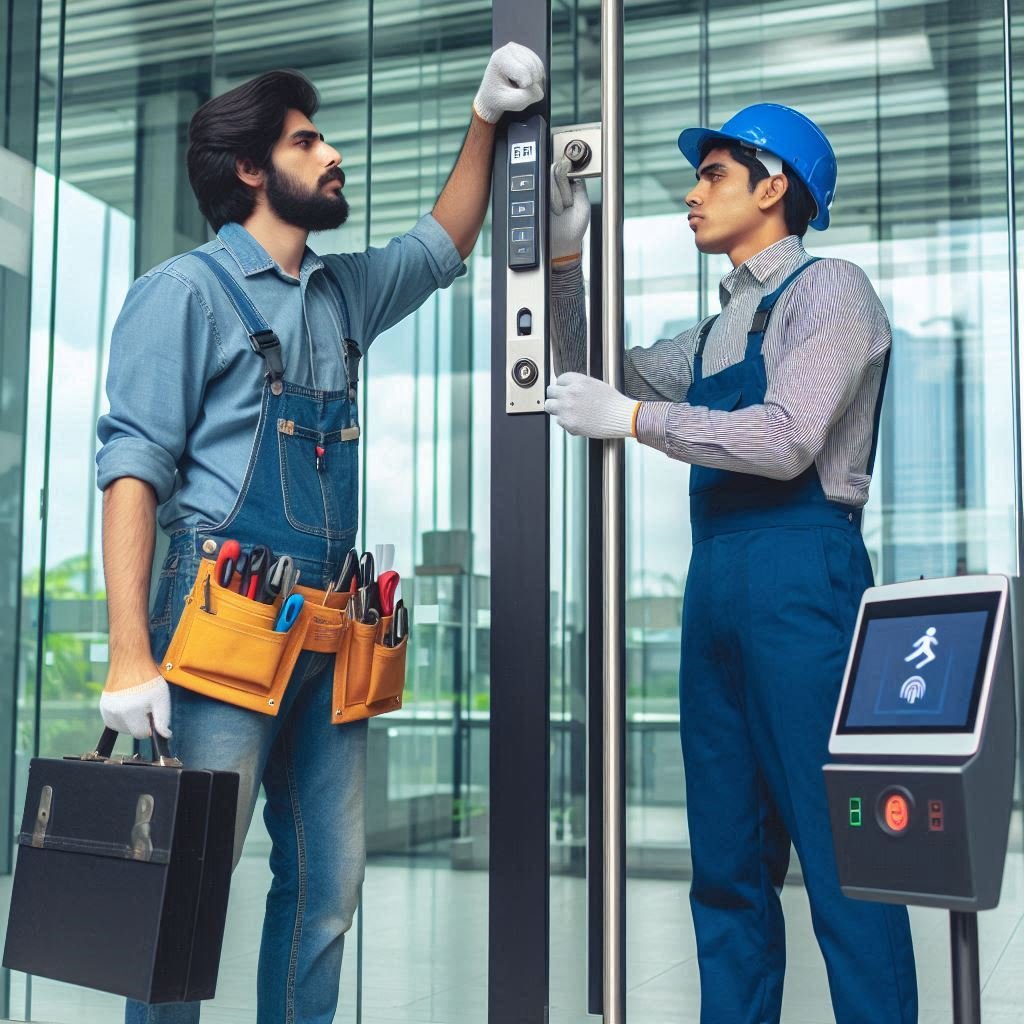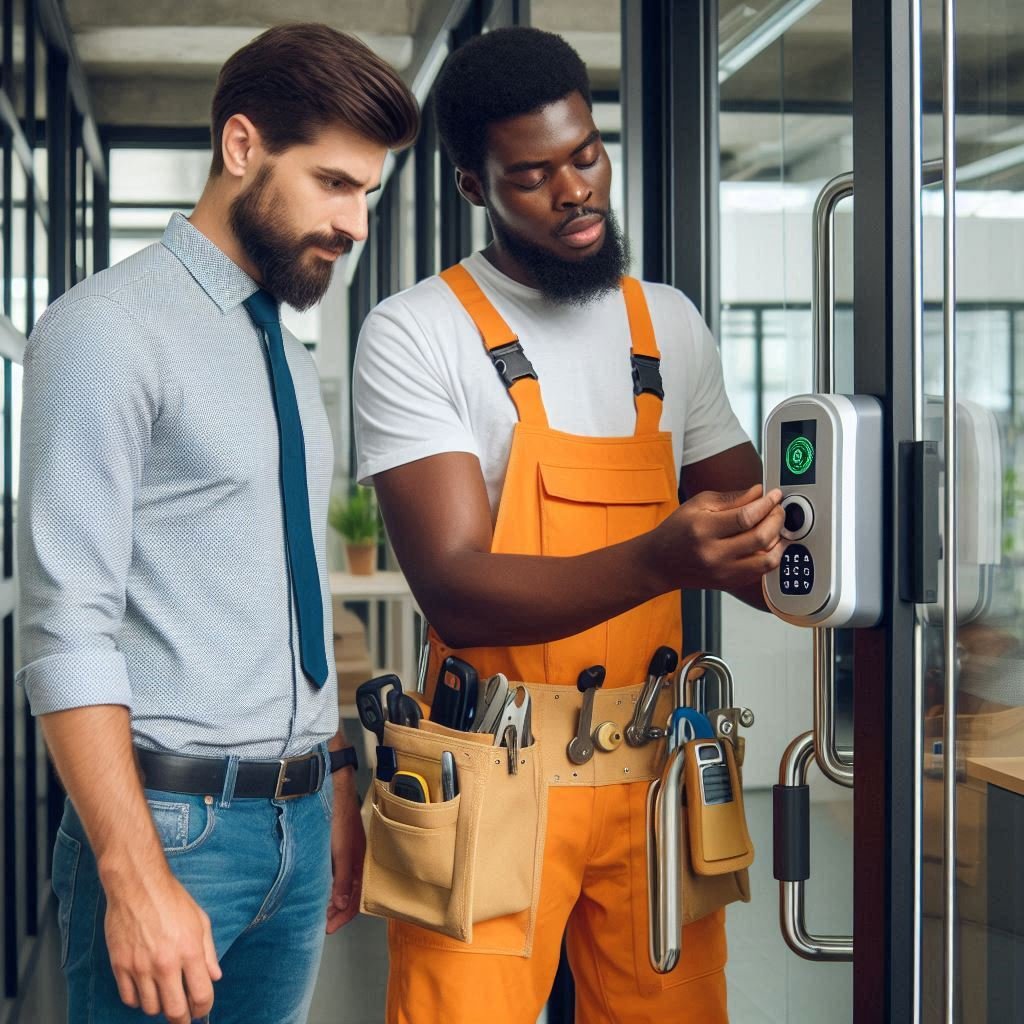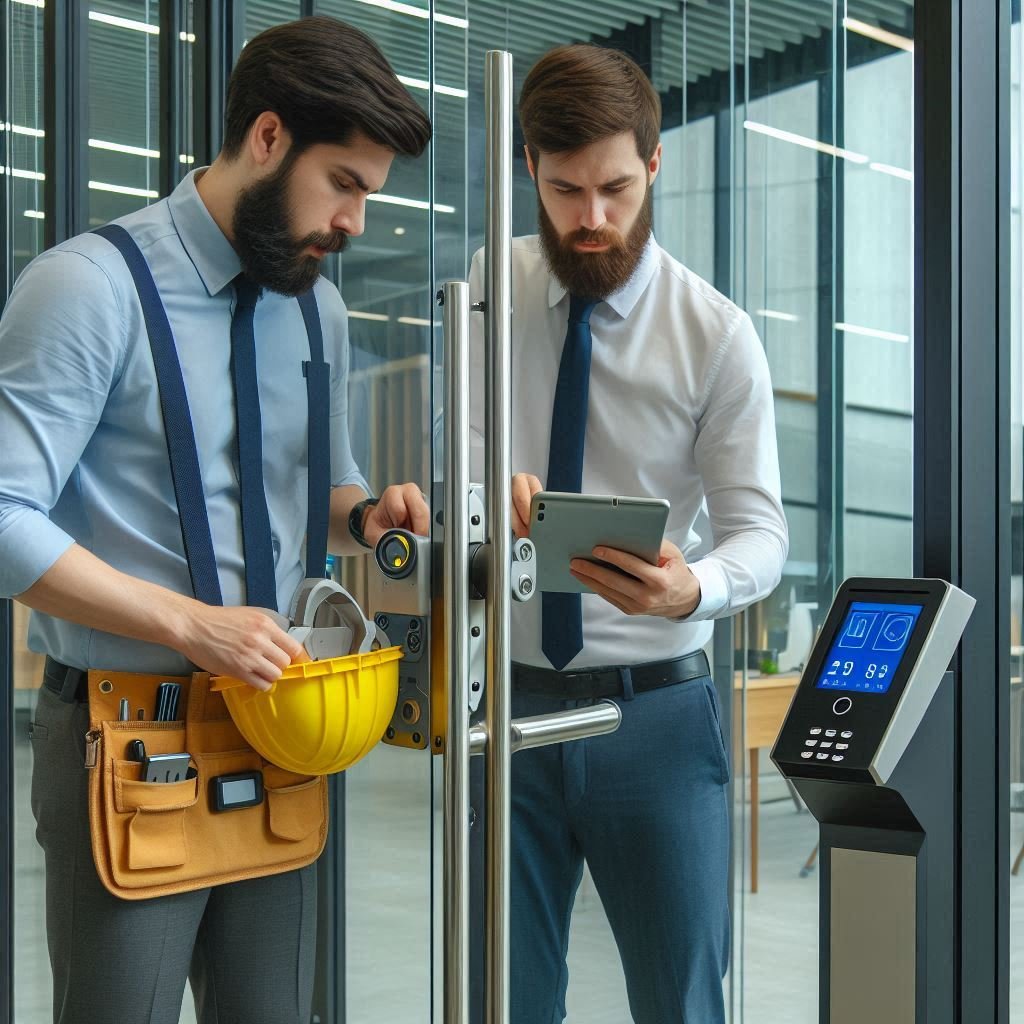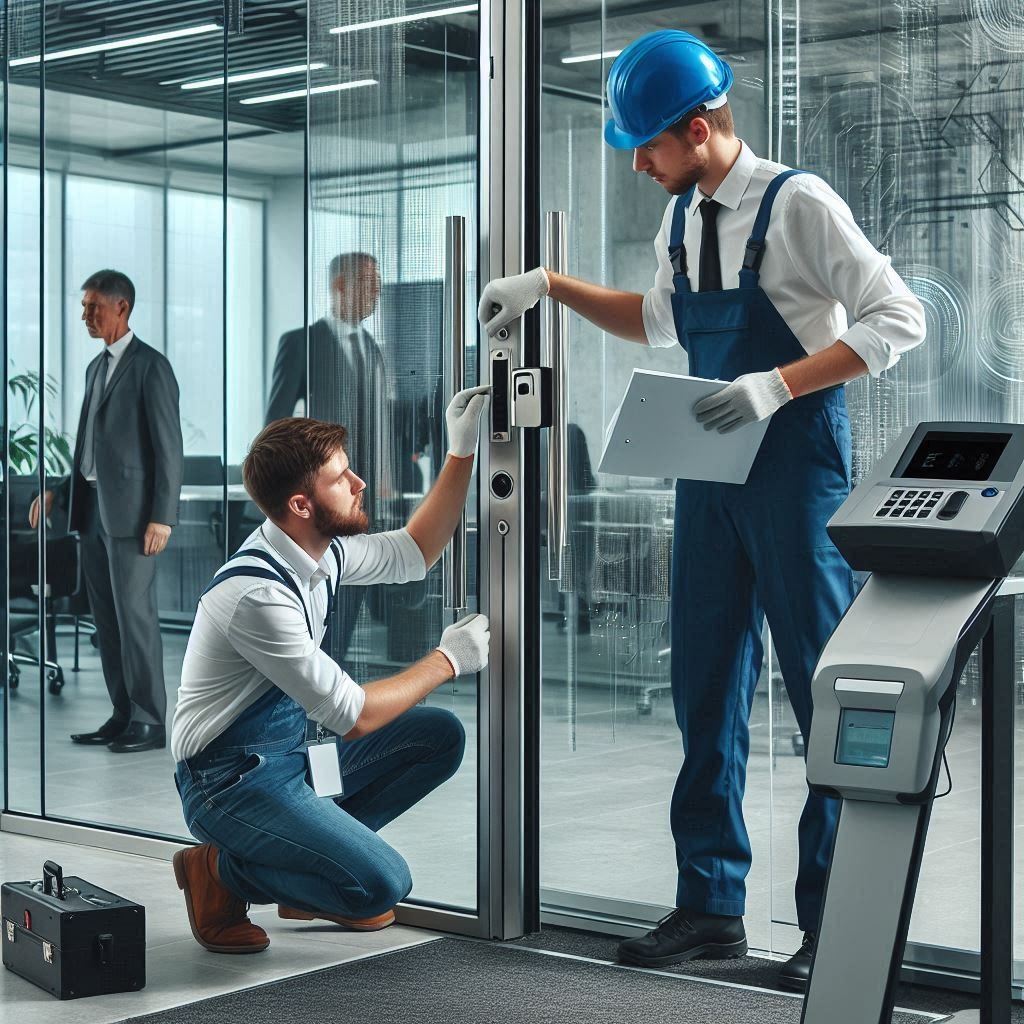Biometric Machine Installation with Access Door Lock
In today’s rapidly evolving security landscape, traditional lock-and-key systems are being replaced by more sophisticated solutions. Biometric Machine Installation access control systems offer enhanced security, convenience, and scalability for both residential and commercial properties. This guide provides an in-depth overview of biometric machine installation services, focusing on integration with access door locks, to help you understand the benefits, installation process, and maintenance of these advanced security systems.
Installing a Biometric Machine Installation with an access door lock enhances security by restricting entry to authorized personnel only. This guide provides a step-by-step installation process, wiring diagrams, and best practices for seamless integration.
Introduction to Biometric Machine Installation Access Control Systems
Biometric Machine Installation access control systems utilize unique biological traits—such as fingerprints, facial features, or iris patterns—to authenticate individuals and grant access to secured areas. Unlike traditional methods that rely on keys or cards, biometric systems provide a higher level of security by ensuring that access is granted only to authorized individuals.
Types of Biometric Authentication Methods
Biometric systems employ various authentication methods, each with its unique features and applications:
- Fingerprint Recognition: Scans and analyzes the unique patterns of ridges and valleys on an individual’s fingertips.
- Facial Recognition: Uses facial features to identify and authenticate individuals.
- Iris Recognition: Analyzes the unique patterns in the colored ring around the pupil of the eye.
- Voice Recognition: Identifies individuals based on the unique characteristics of their voice.
- Palm Vein Recognition: Scans the unique patterns of veins in the palm of the hand.
Benefits of Biometric Access Control Systems
Implementing Biometric Machine Installation access control systems offers numerous advantages:
- Enhanced Security: Biometric traits are unique to individuals, making unauthorized access more difficult.
- Convenience: Eliminates the need for physical keys or cards, streamlining access procedures.
- Audit Trails: Provides detailed logs of access events for monitoring and compliance purposes.
- Scalability: Easily accommodates growing numbers of users without significant infrastructure changes.
- Cost Savings: Reduces expenses associated with lost or stolen keys and cards.
Components of a Biometric Access Control System
A typical Biometric Machine Installation access control system comprises several key components:
- Biometric Reader: Captures and processes biometric data for authentication.
- Access Control Panel: Manages authentication requests and communicates with other system components.
- Electric Lock: Secures the door and is released upon successful authentication.
- Power Supply: Provides necessary power to the system components.
- Software: Enables configuration, user management, and monitoring of the system.
Installation Process
The installation of a Biometric Machine Installation access control system involves several critical steps:
A. Site Assessment
Conduct a thorough evaluation of the installation site to determine optimal placement for the biometric reader and associated components.
B. Hardware Installation
Mount the biometric reader and install the electric lock, ensuring all components are securely positioned and connected.
C. Wiring and Connectivity
Establish necessary wiring for power and data transmission, ensuring compliance with safety standards.
D. Software Configuration
Install and configure the access control software, setting up user profiles, access permissions, and schedules.
E. Testing and Calibration
Perform comprehensive testing to ensure all components function correctly and efficiently.
Integration with Access Door Locks
Integrating Biometric Machine Installation systems with access door locks enhances security by ensuring that only authorized individuals can gain entry. This integration involves configuring the biometric reader to communicate with the electric lock, allowing for seamless access control.
Maintenance and Support
Regular maintenance is essential to ensure the longevity and reliability of Biometric Machine Installation access control systems:
- Routine Inspections: Conduct regular checks to identify and address potential issues.
- Software Updates: Keep the system software up to date to protect against vulnerabilities.
- User Management: Regularly update user profiles and access permissions as needed.
- Technical Support: Provide ongoing support to address any operational challenges.
Components Required
Before installation, ensure you have the following:
✅ Biometric Access Device (Fingerprint/Face Recognition)
✅ Electric Door Lock (Magnetic Lock, Electric Strike, or Mortise Lock)
✅ Power Supply (12V DC, 2-3A)
✅ Exit Button or Motion Sensor (Optional for exit control)
✅ Cables (2-core & 4-core for wiring)
✅ Mounting Screws & Tools (Drill, Screwdriver, Multimeter)
Step-by-Step Installation Guide
1. Choose the Right Door Lock Type
Select a lock based on security needs:
| Lock Type | Best For | Power Requirement |
|---|---|---|
| Magnetic Lock | High-security doors (glass/metal) | 12V/24V DC |
| Electric Strike | Wooden/metal doors with existing latch | 12V DC |
| Mortise Lock | Office/Residential doors (built-in mechanism) | 12V DC |
2. Mount the Biometric Device
- Install at 1.2m – 1.5m height for easy scanning.
- Use wall anchors for concrete/metal doors.
- Ensure proper alignment with the door frame.
3. Wiring Connections
A) For Magnetic Lock (Fail-Safe Mode – Unlocks on Power Cut)
| Biometric Terminal | Magnetic Lock Connection |
|---|---|
| NO (Normally Open) | +12V (Positive) |
| COM (Common) | Lock Negative (-) |
| Power Supply (+12V & GND) | Connected to Biometric & Lock |
B) For Electric Strike (Fail-Secure Mode – Locks on Power Cut)
| Biometric Terminal | Electric Strike Connection |
|---|---|
| NO (Normally Open) | Strike Positive (+) |
| COM (Common) | Strike Negative (-) |
| Power Supply (+12V & GND) | Connected to Biometric & Strike |
4. Power Supply Setup
- Use a 12V DC, 2-3A power adapter for stable operation.
- Add a UPS backup for uninterrupted access during power outages.
5. Exit Button / Motion Sensor (Optional)
- Connect an exit button to the “Exit” terminal on the biometric device.
- Motion sensors can trigger automatic unlocking.
6. Test the System
- Register test fingerprints/faces.
- Verify locking/unlocking via biometric authentication.
- Check fail-safe/fail-secure behavior during power loss.
Troubleshooting Common Issues
❌ Lock Not Opening → Check power supply & wiring continuity.
❌ False Rejections → Re-enroll fingerprints with proper angles.
❌ Device Not Powering On → Test voltage with a multimeter.
Best Practices for Optimal Performance
✔ Use shielded cables to prevent electrical interference.
✔ Install surge protectors for long-term durability.
✔ Regularly clean the biometric scanner for accurate readings.
At Last
A properly installed Biometric Machine Installation door access system ensures high security, convenience, and audit trails. Follow this guide for a smooth installation, or consult a professional for complex setups.
🔧 Need Help? Contact our support team at contact@arcgroupsworld.com or call +917011369789
📢 Upgrade Your Security Today! Shop Biometric Access Kits Now
Frequently Asked Questions (FAQs)
- What is a biometric access control system?
- A system that uses unique biological traits to authenticate individuals and grant access to secured areas.
- How does fingerprint recognition work?
- It scans and analyzes the unique patterns of ridges and valleys on an individual’s fingertips.
- Is facial recognition accurate?
- Yes, but its accuracy can be affected by factors like lighting conditions and facial obstructions.
- Can biometric systems be integrated with existing security systems?
- Yes, many biometric systems are designed to integrate seamlessly with other security infrastructure.
- What are the privacy implications of using biometric data?
- Biometric data is sensitive; therefore, it’s crucial to ensure its secure storage and processing in compliance with privacy regulations.
- How long does the installation process take?
- The duration varies depending on the system’s complexity but typically ranges from a few hours to a day.
- Are biometric systems suitable for small businesses?
- Yes, biometric systems are scalable and can be tailored to fit the needs of small businesses.
- What happens if the biometric system fails?
- Most systems have backup access methods, such as PIN




Karan –
Quality is top-tier, and the customer service is very responsive. Would definitely buy again.